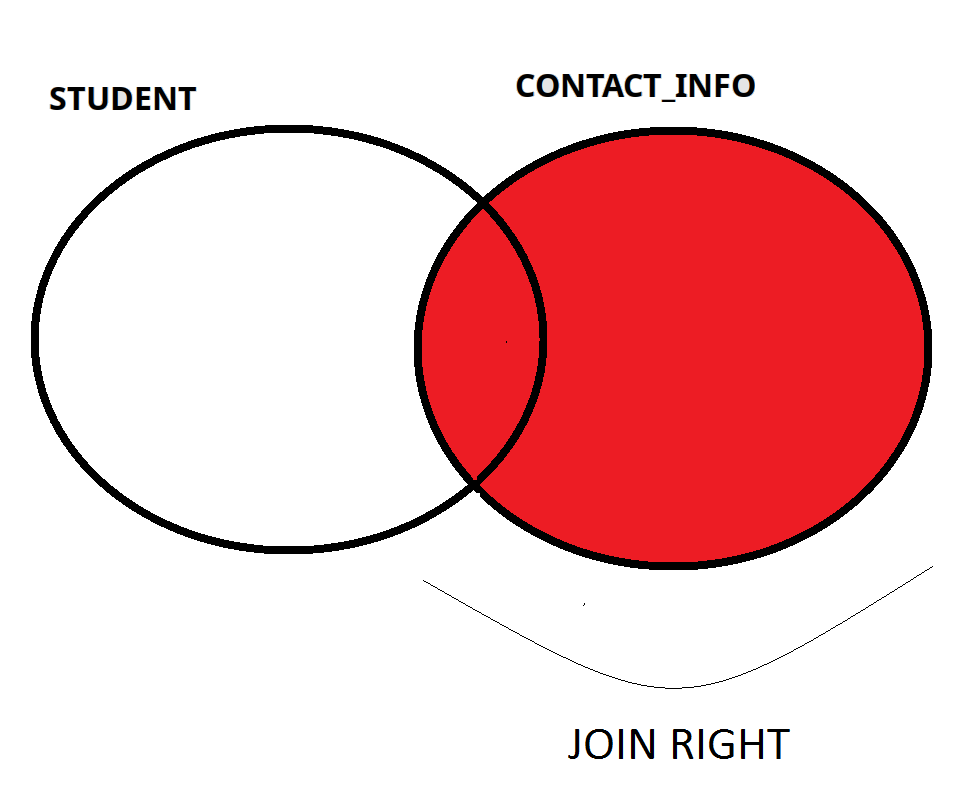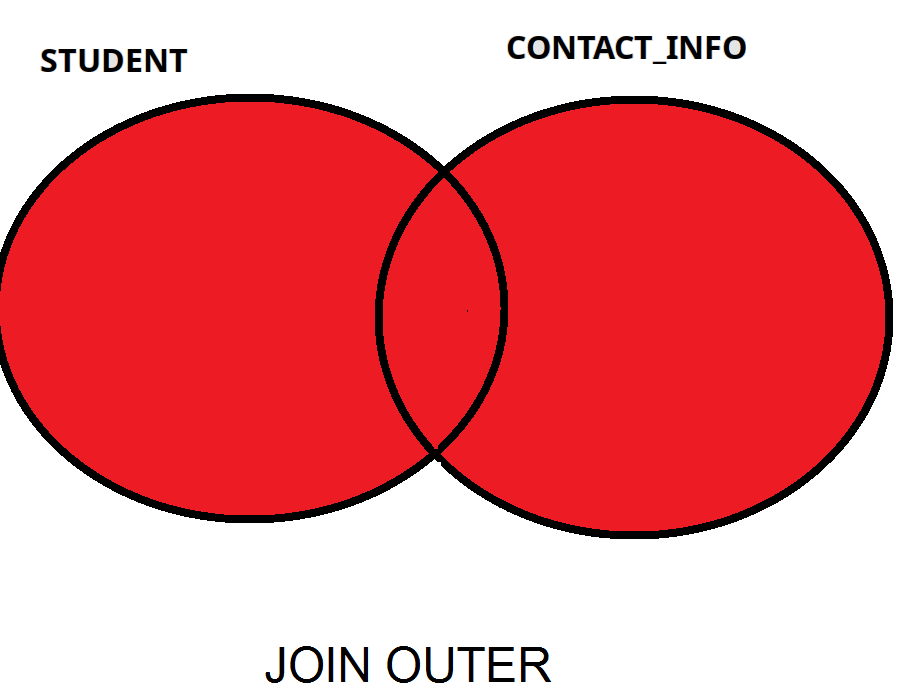35 SQL Join
35.1 Querying multiple tables with Join
- Join
- Inner Join
- Outer Join
- Right outer join
- Left outer join
- Full outer join
- Cross Join
- Self Join
35.2 Join Concept
- joins rows from more than one table according to the given criteria.
- Generally, primary key and foreign key joined.
- For example, Student and Contact table are joined.
- It would be good to think of the join process as a Venn diagram.
- But actually, it is not a set operation
35.3 Inner Join Syntax
Correct syntax for joins ANSI-SQL-92 is below syntax.
SELECT ...
FROM Table1 JOIN Table2
ON Table1.KolonA = Table2.KolonA;Chinook example
Join 2 tables, Artist and Album
SELECT A.Name AS ArtistName
, B.Title AS AlbumTitle
FROM Artist A
INNER JOIN Album B
ON A.ArtistId = B.ArtistId Join 3 tables, Artist, Album and Track.
SELECT A.Name AS ArtistName
, B.Title AS AlbumTitle
, T.Name AS TrackName
FROM Artist A
INNER JOIN Album B
ON A.ArtistId = B.ArtistId
INNER JOIN Track T ON T.AlbumId = B.AlbumId note ANSI-SQL-89 inner join syntax
You may see below syntax for inner join but please do not use it. Using join condition explicitly would always be better.
SELECT ...
FROM Table1, Table2
WHERE Table1.KolonA = Table2.KolonA;It will still works in all databases but giving join conditions using join keyword is always better. Additionally ANSI-SQL-92 syntax for left and right joins are more understandable.
35.4 Inner Join

- Inner join brings the records that match the join condition in both tables. In the following example, 2 tables, Artist and Album are joined and join condition is explicitly given using ON A.ArtistId = B.ArtistId line
SELECT A.Name AS ArtistName
, B.Title AS AlbumTitle
FROM Artist A
INNER JOIN Album B
ON A.ArtistId = B.ArtistId If column name is same in the both tables, we can forgo ON, like below. I dislike this usage and never use it. Please use explicit ON condition.
SELECT A.Name AS ArtistName
, B.Title AS AlbumTitle
FROM Artist A
INNER JOIN Album BThe match is made according to the columns given in the ON word. More than one column can be combined.
For example, if a student does not have contact information, that student’s information will not come.
If = operator is used in a join, it is also called an equi-join.
other operators like >, >= could also be used in join conditions then they are called non-equi-join. Non-equi-joins are rarely used.
35.5 Outer Join
All rows from the specified table are in the result set but only the matching rows from the other table are in the result.
Specified table(s) is decided by using “LEFT, RIGHT, FULL” keywords.
All rows of the specified table are in the result set.
NULL is used for the column information that does not match the given join condition.
For example, NULL will be in the information section for new employees who do not assigned any customers information. Or, any new customer who does not have support representation employee will not be in the results.
Lets insert a new customer with no support representation with following query.
INSERT INTO Customer( FirstName, LastName, Email )
VALUES( 'New Customer First Name', 'New Customer Last Name', 'new@customer.com');Also insert a new employee.
INSERT INTO Employee( FirstName, LastName)
VALUES( 'New Employee First Name', 'New Employee Last Name' ); First lets start with basic Inner join
SELECT
c.CustomerId
,c.FirstName as CustomerFirstName
,c.LastName as CustomerLastName
,e.FirstName as SupportRepresentatorFirstName
,e.LastName as SupportRepresentatorLastName
from Customer c INNER JOIN Employee e
on c.SupportRepId = e.EmployeeId This will bring as 59 rows.

Since we used inner join only those customer who has support employees are in the result. We do not see either of our newly inserted customer or employee in the result.
35.6 Right Outer Join
Change inner join to right join in our sql query.
SELECT
c.CustomerId
,c.FirstName as CustomerFirstName
,c.LastName as CustomerLastName
,e.FirstName as SupportRepresentatorFirstName
,e.LastName as SupportRepresentatorLastName
from Customer c RIGHT JOIN Employee e
on c.SupportRepId = e.EmployeeId We see 6 new rows in the result set. These new rows are those employee with no assigned customers. Since they have no matching information in the Customer table, the columns from Customers are null in the result.

The Venn diagram for Right join is below.

35.7 Left Outer Join
Change inner join to left join in our sql query.
SELECT
c.CustomerId
,c.FirstName as CustomerFirstName
,c.LastName as CustomerLastName
,e.FirstName as SupportRepresentatorFirstName
,e.LastName as SupportRepresentatorLastName
from Customer c LEFT JOIN Employee e
on c.SupportRepId = e.EmployeeId We see only 1 new rows in the result set. This new row is our newly inserted customer with no support representation. Since this customer have no matching information in the Employee table, the columns from Employee are null in the result.

The Venn diagram for Left join is below.

35.8 Full Outer Join
Change inner join to full join in our sql query.
SELECT
c.CustomerId
,c.FirstName as CustomerFirstName
,c.LastName as CustomerLastName
,e.FirstName as SupportRepresentatorFirstName
,e.LastName as SupportRepresentatorLastName
from Customer c FULL JOIN Employee e
on c.SupportRepId = e.EmployeeId We see only 7 new rows in the result set. One new row is our newly inserted customer with no support representation. And other 6 rows are those employees with no assigned customers. Any not matching information are returned as null in this result set as below.

The Venn diagram for Full outer join is below.

35.9 SQL Self Joins
- Joins the rows from the same table.
- Create 2 virtual copies of the same table used in the the FROM clause. Compare the rows with each other using the join condition.
- At least one alias is required for this operation.
- Giving a meaningful name to aliases will help you understand sql better later.
- In the below example, Manager (M) is used for aliases.
Chinook reports to which manager example
SELECT E.EmployeeID
,E.LastName AS EmployerLastName
,E.FirstName AS EmployerFirstName
,E.ReportsTo
, M.EmployeeID as ManagerID
, M.LastName AS ManagerLastName
,M.FirstName AS ManagerFirstName
FROM Employee E
INNER JOIN Employee M
ON E.ReportsTo = M.EmployeeID 35.10 Cross Join
Cross join Cartesian multiply the rows in two tables
For example, let’s make a cross join on Student and Contact tables.
| Öğrenci | İletişim | SONUÇLAR | |||||
|---|---|---|---|---|---|---|---|
| Öğrenci No | Öğrenci | Öğrenci No | İletişim | ||||
| 1 | Atilla | 1 | ati@email1 | Atilla ati@email1 | |||
| ati@email1 | Atilla ati@email2 | ||||||
| 2 | Aydin | 2 | aydin@email1 | Atilla aydin@email1 | |||
| Aydın ati@email1 | |||||||
| Aydın ati@email2 | |||||||
| Aydın aydin@email1 |
- Results will 2*3 = 6 rows.
- Apart from Test data creation, it is normally unwanted.
Following cross join sql in Chinook, cartesian multiply Genre and MediaType tables and bring us 125 rows.
SELECT G.Name,M.Name
FROM Genre G CROSS JOIN MediaType M;- Genre 25 rows
- MediaType 5 rows